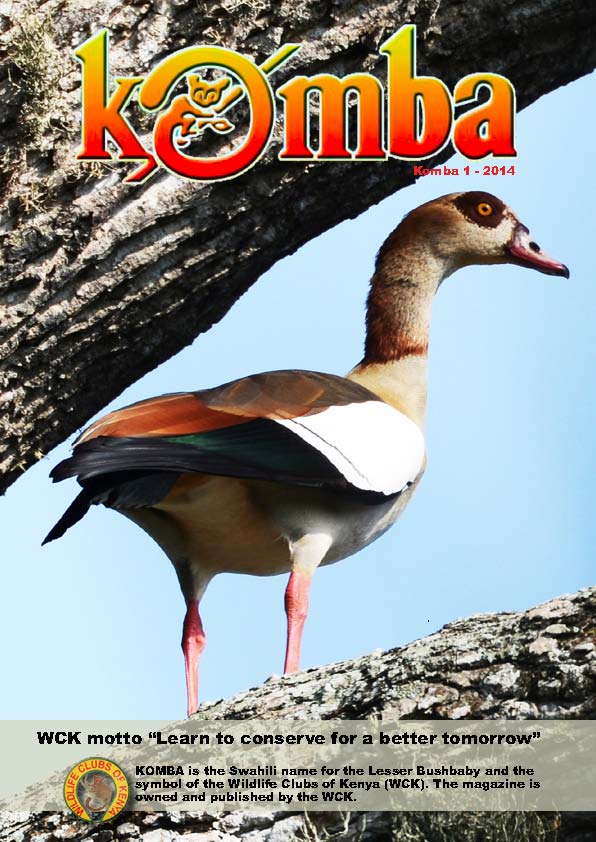News Archive
The Freshwater Fishes of Kenya book launched at National Museums
On Wednesday 4th December, there was a special event at the National Museums of Kenya (NMK) as the Guest of Honour Prof. Micheni Japhet Ntiba, Principal Secretary of the Ministry of Agriculture, Livestock and Fisheries but also a scientist known for his pivotal work on the reproductive cycle of the Siganidae (Rabbitfishes, some of the most important food fishers for Kenyan coastal populations) unveiled the long-awaited “Guide to the Common Freshwater Fishes of Kenya†written by our very own KENWEB coordinator Wanja Dorothy Nyingi. There were wonderful speeches by the Principal Secretary, by the Director of NMK Dr. Idle Farah, by David Muita CEO of Moran Publishers and of course by Dr.Nyingi herself, who prudently described what has probably been one of the longest gestation histories of any popular fishes guidebook with ups and downs, reversals, blockages, changes of editorial policies, etc. but finally produced by local publisher Moran http://www.moranpublishers.co.ke/ and wonderfully so.Â
Dedicated to the memory of the founder of the ichthyology (fish) department of the National Museums Dr. Luc De Vos, who left us all much too soon and very much orphaned, the book generally illustrates and describes about 200 of the most common fish species to be found in Kenya’s main rivers, lakes and swamps.Â
More precisely the book contains:
Morphological descriptions of the most important features of the various fish species
Colour photos and illustrations to enable visual recognition of fish
The distribution ranges of the fish species
The names of the fish in local languages and in English
The ecology and behaviour of these fish, including their food preferences, reproductive behaviour and preferred habitat
Information on the importance of the fish or common uses such as subsistence or artisanal fishing, commercial fishing, aquaculture, aquarium trade or sports fishing
The book is a great thing to take into the field and hopefully a stimulus for many more people to go out and understand what is moving under the surface of our many wonderful wetlands and to contribute to their conservation and restoration.
KENWEB botanist awarded the Fairchild Medal

Quentin Luke, KENWEB’s tireless botanist and co-discoverer of most of the exceptional biodiversity of the Tana Delta (the colobus and mangabey, the Madagascar Pratincoles, etc.) and responsible for taking its plant species list from 300 to almost 800, many of them threatened and several of them new to science, has been awarded the equivalent of the Nobel Prize for Field Botany: the David Fairchild Medal for Plant Exploration. Given out annually by the National Tropical Botanical Garden (NTBG) of the US of A, it rewards distinguished service to humanity by exploring remote areas of the world, using innovative travel itineraries, conveyances, or techniques to discover new plant species, playing a crucial role in the ex situ cultivation of rare or endangered plant species and ensure preservation of threatened and endangered habitats and natural communities. Quentin is best known for his work on the sacred Mijikenda Forests or Kayas of the Eastern African seaboard which largely through his work in the 1990s, are now recognised by Unesco as World Heritage Cultural Landscapeshttp://whc.unesco.org/en/list/1231 Those of us fortunate enough to spend time in the field with Quentin (and who in addition have the physical stamina to keep up with him when he crashes through tangled and spiny vines, crawls over slippery branches crossing croc-infested waters or trundles knee-deep through the mud of seemingly endless marshes) know that he is not only the walking encyclopaedia of East African Plant life and the IUCN red-list authority for the region but also a great teacher, a critical thinker, a fun companion and an extremely knowledgeable naturalist for an endless series of species groups other than plants. Armed only with secateurs, a plastic bag, a petrol fuelled plant drier, a GPS, a mosquito net and some dry foodstuffs he can spend days collecting in the most inhospitable places, on condition that there is real coffee not this powdered ersatz that some Swiss companies are mass-producing to the detriment of South-East Asia’s most valuable forests. The director of the NTBG puts it in these terms: “Quentin personifies the old-fashioned, no-frills plant collector ethic. Guided by his life-long commitment to Africa, its plants and people, and naturally possessing a keen sense of exploration and discovery, Quentin is an ideal recipient for the Fairchild Medal.â€
Congratulations Quentin, well deserved!
"Freshwater Fishes Guide" Review by Swara Magazine
Fish are one of the most fascinating and important components of Kenya’s biodiversity. One of the great challenges facing understanding and appreciating the diversity of fish in Kenya has been the lack of an accessible guidebook. As many of us who occasionally bother playing around fish with rods and lures can attest, often one pulls something out of the water that one doesn’t immediately recognise and this can be very frustrating.
The publication of this delightful little book fills a large gap in our knowledge and ability to identify fish in Kenya. Dr Nyingi has put together a compact publication that will prove useful to anyone interested in identifying the fish that they catch or observe in rivers, lakes and wetlands across the country.Â
Click here to download full article
KENWEB Joins ICCA Consortium

Â
KENWEB is proud to announce that it has been accepted as a member of the ICCA Consortium http://www.iccaconsortium.org/
The ICCA consortium is an international organisation dedicated to promoting the appropriate recognition of and support to Indigenous Peoples’ and Community Conserved Areas and Territories. We believe, like walking on water lilies for this Black Crake, that the situation in Kenya is a difficult balancing act. Indigenous communities, with the exception of the Ogiek, have not really been officially recognised, the ethnic issue has been completely politicised and communal land rights are a very hot potato anyway. Many of the potential ICCAs are being gobbled up in all sorts of setups, sometimes with the backing of the green-grabbing type of conservation NGOs who are not beyond taking a few shortcuts around the free prior and informed consent by the concerned communities. In Kenya there is also a long tradition of “conservanciesâ€, the governance of which is not always top notch, ranging from the exploitative, with virtually no benefits accruing to the community or only to a few individuals in it, and then all the way to the marvellously pure of heart but that lack means to implement crucial management interventions such as surveillance or securing their water rights. In addition, many of the world’s most famous protected areas have actually been established on non-formalised ICCAs and its dispossessed people have faced enormous difficulties in maintaining access to some of their most vital resources, including spiritual. With climate change making the fenced and state-controlled approach to biodiversity conservation increasingly irrelevant, there is recognition that networks of well-governed and appropriately supported ICCAs (with the wrong approach they can be totally wrecked in no time at all) are increasingly an avenue for the conservation of significant landscapes that integrate multiple uses. That also means the pressure is on from all sides to either convert them to single use from large-scale agriculture (irrigation, biofuels) to fortress conservation type areas. The money that some unscrupulous characters smell in REDD+ also brings out some of the worst behaviour in human society. It will always be hard to empower the powerless. So we need to tread carefully and ethically
Should we build more large dams?
“The actual costs of hydropower megaproject developmentâ€

Ever since the World Commission on Dams (WCD) report in 2000, the environmental and social impacts of dams, and especially large storage dams for hydropower production have been under close scrutiny and its recommendations were largely integrated by the multilateral funding agencies which basically led to a “drought†in dam construction in Africa.
However, with the economic boom in emerging nations in Asia and South America, dam building started again but with different sources of funding, in its most extreme version the so-called “boot†dams (build-own-operate-transfer) on, for example, the Mekong.
The mechanism is simple: private funding (in this case based on the electricity demand of air conditioning offices and middle class housing in cities like Bangkok) signs a deal with a poor country (e.g. Laos) builds the dam and sells the electricity for a number of decades, reimbursing itself with a handsome profit. The dam is then transferred to the country (but of course its useful life time has expired, it is full of sediment, etc.). The thing is that this kind of money is not subjected to any environmental or social criteria (or these can be negotiated downward with the receiving country, possibly with some personal incentives for those who sign). The dam-building epidemic has now spread to Africa, often with new bilateral donors who have also not signed up to the recommendations of the WCD.
Many of the most damaging aspects of dams can be reduced by making them either run-of-the-river i.e. without storage and only producing power during good river flows (and interlinking power grids – it always rains somewhere in Africa) or, if storage is unavoidable, design and operate for managed flood releases that can keep the downstream ecosystems and sociosystems operating or even improve on them.
As can be seen from the picture of Masinga dam (the biggest storage dam on the Tana River) during a recent drought in Kenya, planning for a dam with rainfall and run-off data most often from the 1960s does not guarantee that they will actually have water in the 21st century.
Bent Flyvbjerg and his team have been writing about cost overruns in various types of megaprojects for many years now but this one on dams is a real eye-opener showing that it, in general, they also do not make economic sense.
Â
by Atif Ansar, Bent Flyvbjerg, Alexander Budzier and Daniel Lunn
The paper can be downloaded at
http://ssrn.com/abstract=2406852
The Future of Large Dams

Anthropologist Ted (Thayer) Scudder has spent most of his life studying displaced people, including by large dams. He was one of the key authors on the, now all too easily ignored, World Commission on Dams report. It is strange how little the suffering of the people affected by dams, both upstream and downstream, gets into our hearts and minds.
Click here to download a review on the book
Â
Tana Delta, The Movie
Latest News
-
FriOct242014The National Museums of Kenya (NMK) is hosting its 5th edition of the S...
-
FriOct032014Click image to download strategy








 Click image to download strategy
Click image to download strategy


